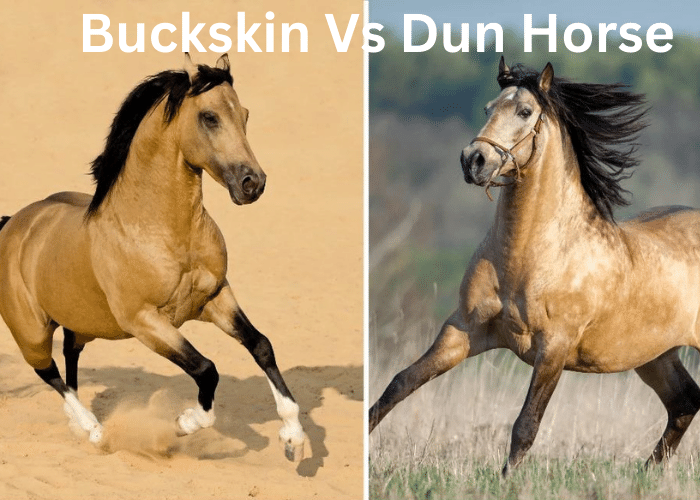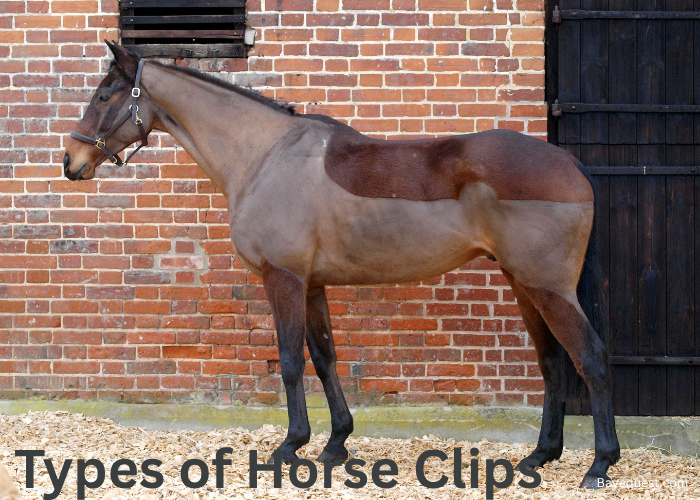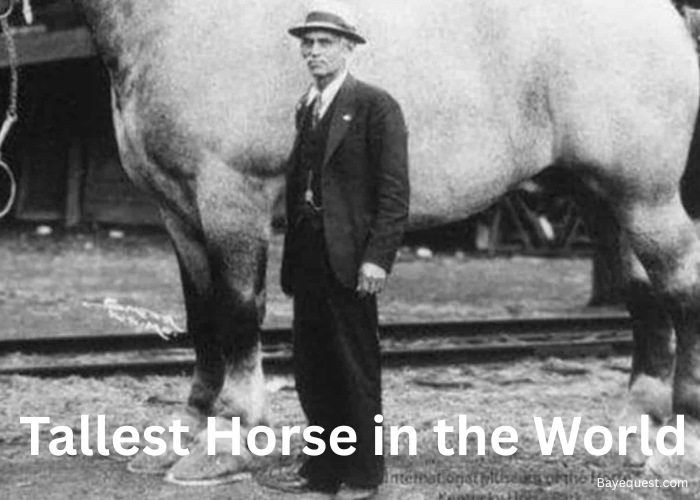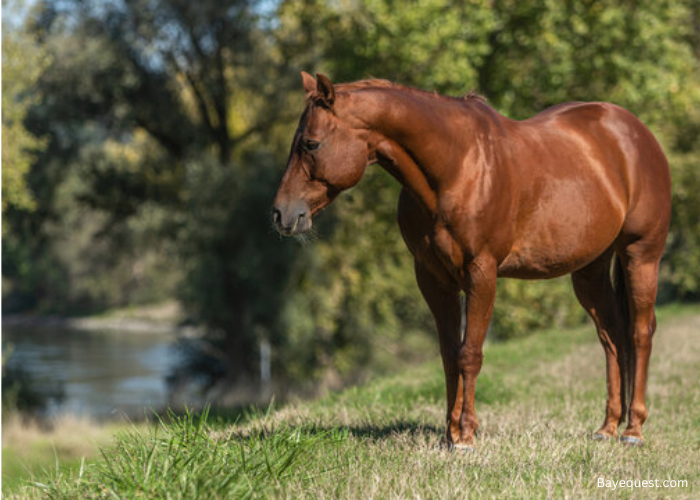Did you know that two horse colors often confuse even seasoned equestrians? Buckskin and dun, while similar at a glance, hold distinct differences.
With years of experience in horse breeding, I’ve seen many mistake one for the other. Are you one of them?
This article will clarify the confusion and detail how to distinguish these beautiful hues. Are you ready to unravel the mystery of buckskin vs dun horses?
Let’s dive in and set the record straight.
What is the Difference Between Dun and Buckskin? Key Takeaway
Although buckskin and dun horses look similar, they are genetically distinct. Buckskins are bay horses with one cream dilution gene, resulting in a golden coat. Duns, however, have a dorsal stripe and primitive markings due to the dun gene, creating a more muted coat color. Understanding these differences helps in accurate identification.
What is a Buckskin Horse?
A Buckskin horse is not just a feast for the eyes with its golden-hued coat. It’s a tapestry of history, genetics, and versatility woven into one magnificent creature.
Here’s a deeper dive into the world of Buckskin horses.
Origin
The Buckskin horse traces its roots back to the Spanish Sorraia and Barb horses brought to the Americas by Spanish explorers. These horses are known for their hardiness and endurance.
They are mixed with the native horse populations, leading to the distinctive color and traits we see in Buckskins today.
The color became especially prevalent in the American West, where these horses were highly valued by Native Americans.
Physical appearance
Height: Buckskin horses stand between 14.2 to 16 hands (58 to 64 inches) at the shoulder. However, their height can vary depending on the breed they belong to.
- Weight: They usually weigh between 950 to 1,200 pounds, with some variation based on breed and body type.
- Lifespan: Buckskins can live for 25 to 30 years with proper care and management.
- Colors: The defining feature of Buckskin horses is their coat color, which ranges from a light cream to a rich gold. Their mane and tail are often a darker shade.
- Uses: Buckskin horses are prized for their versatility and are used in various disciplines. These include Western pleasure, endurance riding, dressage, and jumping. They are also popular as trail and working ranch horses.
- Trainability: Buckskins are generally easy to train.
Variations
While the classic Buckskin colour is well-known, shades vary from a very light, almost cream colour to deep, rich gold. The shade can depend on factors like diet, season, and genetics.
Despite these variations, the distinct contrast between the body color and the darker points (mane, tail, and lower legs) remains a hallmark of the Buckskin.
Genetic basics
The Buckskin color results from the action of a single cream dilution gene on a bay base coat. This gene dilutes the red pigment in the bay coat, resulting in the golden hue of the Buckskin.
However, the gene does not affect the black pigment, which is why the mane, tail, and lower legs remain dark. This dominant genetic trait means that only one copy of the gene is required to produce the Buckskin color.
What is a Dun Horse?
Dun horses, with their earth-toned coats and primitive markings, are as much a nod to the ancient past as they are a presence in the modern equine world.
These horses, distinguished by their unique coloration and genetic markers, carry the legacy of wild ancestors. They are celebrated for their beauty, versatility, and gentle temperament.
Origin
The Dun coloration is one of the oldest and most widespread in horses, believed to trace back thousands of years. Ancient cave paintings depict horses with Dun characteristics.
This suggests their presence across various parts of the world since prehistoric times. This coloration is thought to have played a role in camouflage and protection from predators.
Physical appearance
Height: The height of Dun horses can vary depending on the breed, but range from 14 to 16 hands (56 to 64 inches).
- Weight: Dun horses weigh between 900 to 1,200 pounds, influenced by their breed and build.
- Lifespan: Dun horses can enjoy a lifespan of 25 to 30 years, which is common among domesticated horses.
- Colors: The Dun horse color spectrum includes shades from light, sandy yellow to a rich, mousey brown. What sets Dun horses apart are the primitive markings, such as a darker buckskin dorsal stripe running down the spine, horizontal stripes on the legs, and sometimes a shoulder stripe or shadow.
- Uses: Duns excel in various disciplines from western and endurance riding to dressage and jumping. Their calm demeanor and intelligence also make them excellent family and trail horses.
- Trainability: These horses are highly trainable and suitable for riders of all levels.
Variations
Dun horses display a range of color variations, each with its distinct name:
- Classic Dun: Features a tan or gold body with black points (mane, tail, and legs) and primitive markings.
- Red Dun: Has a reddish or orange body color with darker red points and primitive markings.
- Grullo (or Grulla): Characterized by a smoky or mousey gray body color, often with black points and pronounced primitive markings. Read more on Grulla horse color shades in this other blog.
Genetic basics
The Dun factor is a dominant genetic trait characterized by the dun dilution gene (D). This gene dilutes the base coat color, leading to the unique Dun shades while preserving the darker color of the primitive markings.
Unlike the cream dilution gene that creates Buckskins, the Dun gene affects black and red pigments. A horse only needs one copy of the Dun gene to display the Dun coloration and its associated markings.
However, if a horse inherits two copies of the gene, it does not intensify the Dun characteristics; the presence is enough to manifest the traits.
Differences Between Buckskin and Dun Horse
So, you’re wondering how to tell apart a Buckskin from a Dun horse? It can get a bit tricky, but once you know what to look for, it’s like finding the hidden picture in those magic eye books.
Dun Horse Vs Buckskin: Misleading patterns
Here’s the thing. Dun horses come with unique designs. These aren’t just any marks; they’re called primitive markings.
Imagine a horse with stripes like a zebra on its legs or a dark line running down its back. That’s your Dun horse.
Buckskins, though, don’t have these. So, when you’re looking for a Dun, think about looking for a horse that’s wearing nature’s own special markings.
Buckskin Vs Dun Horse: Primitive spots on Dun horses
Now, about those spots on Dun horses. It’s pretty cool. Some Dun horses have these little, darker spots spread out over their lighter coat.
Picture a canvas, and someone’s flicked dark paint across it. These aren’t random; they’re part of what makes a Dun a Dun.
Buckskins? They don’t have this kind of pattern. Their coat is more like a single, smooth color all over.
Buckskin Horse Vs Dun Horse: The fur of dun horses is not uniformly colored
Dun horses have this interesting thing going on with their fur. It’s not just one color. Their fur has shades – some parts lighter, some darker. It gives them a sort of sun-kissed look, like the color’s been brushed on.
Buckskins, on the flip side, have a more even, one-tone color across their entire body. It’s a clear, solid color, no mixing.
Dun Horse Vs Backskin Horse: Distinct dilution genes create buckskin and bay dun
This is where genetics comes into play. Buckskin and Dun horses look different because of their genes.
Buckskins have the cream dilution gene. Think of it as adding a bit of cream to coffee; it lightens the whole thing up.
That’s what happens to their coat. But Duns? They have the dun dilution gene. This one’s a bit different. It’s responsible for those striking primitive markings and the mixed shades in their fur.
So, while both are beautiful, they’re beautiful in their own genetically unique way.
Similarities of Buckskin and Dun Horse
Buckskin and Dun Horse are from the same family. So, let’s look at some of their similarities:
Buckskins Vs Duns: Same base color
Both Buckskin and Dun horses kick off with a similar starting point – a base coat that’s essentially a rich, earthy tan. This base is the canvas from which their unique coat colors are painted.
Think of it as the backdrop of a masterpiece; it sets the stage for the beautiful variations that follow.
Buckskin Horses Vs Dun Horses: Diluted coat color
Here’s where things get interesting. Both Buckskins and Duns have coats that aren’t bold and bright but softened, like they’ve been gently faded by the sun.
This dilution gives their coats a dreamy, muted quality. It’s as if someone turned down the saturation, leaving them with a soft, enchanting hue.
Dun Horses Vs Buckskin Horses: Tan colored coats
Tan coats are the hallmark of both Buckskin and Dun horses. This isn’t just any tan, though. It ranges from a creamy, almost beige to a rich, golden brown.
Imagine the colors of the desert at sunrise – those warm, glowing shades? That’s what we’re talking about here. Both horse types wear this spectrum of tan like a natural cloak.
Duns Vs Buckskins: Balck manes and tails
Now, onto the manes and tails. For both Buckskins and Duns, their manes and tails often come in a striking black or very dark brown. (See why manes are important for horses in our other guide.)
This creates a beautiful contrast against their lighter body color. Picture a golden landscape under a dark, stormy sky.
The contrast is dramatic and beautiful, just like on these horses.
Buckskins and Duns: Brown eyes
Finally, let’s not forget the eyes. Both Buckskins and Duns have brown eyes. But we’re not talking about just any brown.
This is a deep, expressive brown that seems to hold stories within. It’s the kind of warm, inviting look that draws you in, making these horses not just beautiful on the outside but captivating to gaze into.
See also: Sorrel Vs Chestnut Horse.
Buckskin Vs Dun Horse Comparison Chart
| Feature | Buckskin horse | Dun horse |
| Base Color | Earthy tan base color. | Earthy tan base color. |
| Coat Dilution | Cream dilution gene lightens the coat. | Dun dilution gene creates a lighter coat with primitive markings. |
| Coat Color | Uniform tan or golden coat without primitive markings. | Tan with a variation of shades, including primitive markings like dorsal stripes. |
| Mane and Tail | Black or dark brown, providing a stark contrast. | Typically black or dark brown, especially in classic duns, offering a vivid contrast. |
| Primitive markings | None. Buckskin horses do not have dorsal stripes or leg barring. | Present. Includes a dorsal stripe, leg barring, and sometimes shoulder stripes or face masking. |
| Eye Color | Predominantly brown. | Predominantly brown. |
| Genetic Basics | Caused by a single cream dilution gene on a bay base coat. | Caused by the dun dilution gene, affecting all base colors and adding primitive markings. |
| Common uses | Versatile | Versatile |
| Personality and Trainability | Gentle temperament and trainability. | Also praised for intelligence, willingness to learn, and gentle nature. |
Related read: Bronco vs Mustang.
Which One Should I Choose? Buckskin or Dun Horse?
Choosing between a Buckskin and a Dun horse comes down to personal preference. Both types have their unique beauty and characteristics, making them excellent companions for various activities.
Here’s a little guidance to help you make your choice:
Consider your preferences in appearance
Buckskin. If you’re drawn to a horse with a solid, golden coat that shines like the sun, a Buckskin might be your dream horse.
Dun. If you’re captivated by the idea of owning a horse with ancient, wild markings like dorsal stripes and leg barring, a Dun could be the one for you.
Think about your activities
Both Buckskins and Duns are versatile and can excel in various disciplines, from trail riding to competitive sports. Consider the specific activities you’re interested in. For general purposes, both types are equally suitable.
Reflect on personality and trainability
Generally, both Buckskin and Dun horses are known for their good temperaments and trainability. However, individual equine personality varies more by breed and individual horse than by color.
If you have the chance, spend time with horses of both colors to see which one you connect with on a personal level.
Availability and budget
Availability in your area might influence your choice. Some regions might have more Buckskins or Duns.
Consider your budget. The price can vary depending on the horse’s breeding, training, and specific qualities, rather than its color.
Follow your heart
Sometimes, the decision comes down to that special spark you feel when you meet the right horse. It might not be about color at all, but the connection you share.
Conclusion
So, there you have it, the scoop on Buckskins and Duns. Like two sides of a beautiful, sun-kissed coin, each horse brings its flavor to the stable.
Buckskins dazzle with their golden glow, while Duns tell ancient tales with striking stripes. Choosing between them? It’s not just about color.
It’s about the heart-thumping moment you lock eyes and know, “This is the one.” Whether you lean towards the uniform beauty of a Buckskin or the wild charm of a Dun, remember: it’s the connection, the shared whispers on long rides, that truly matters.
Buckskin or Dun, you’re not just picking a horse. You’re choosing a journey. Let your heart lead the way.








